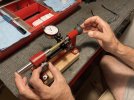The complaint is too much play in spindals, cartridge rims varying and not being centered in taper on case head spindal, bullet spindal off centered and throwing off reading..... etc.The Hornady sux in every regard. But that's another thread.
The instructions say to apply pressure on case head spindal with inserted cartridge until the bullet spindal knob is approximately and 1/8 inch from the base. In this case there is play to throw off the reading ESPESIALLY when you rotate the cartridge with the knob, but not so much when the cartridge is turned with your fingers. What I do is apply light pressure on the case head spindal with my middle finger and hold the bullet spindal and with my fore finger and tighten the case head locking knob until there is no slack on the cartridge between the spindals.
Attachments
Last edited:

